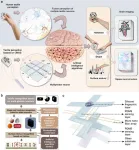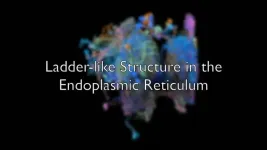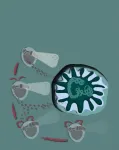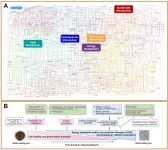(Press-News.org) Research Highlights:
In a randomized clinical trial in China, giving the clot-busting medication alteplase up to 24 hours after stroke symptoms first appeared increased the odds of better recovery by 50% compared to those who received standard antiplatelet treatment.
The results might extend the time window for patient treatment worldwide, particularly in regions that lack access to advanced medical procedures.
Note: The study featured in this news release is a research abstract. Abstracts presented at the American Heart Association’s scientific meetings are not peer-reviewed, and the findings are considered preliminary until published as full manuscripts in a peer-reviewed scientific journal.
Embargoed until 12:03 p.m. PT/3:03 p.m. ET Friday, Feb. 7, 2025
LOS ANGELES, Feb. 7, 2025 — The clot-dissolving medication, alteplase, improved stroke patients’ recovery by more than 50% when given up to 24 hours after the beginning of an ischemic stroke, according to preliminary late-breaking science presented today at the American Stroke Association’s International Stroke Conference 2025. The conference, in Los Angeles, Feb. 5-7, 2025, is a world premier meeting for researchers and clinicians dedicated to the science of stroke and brain health.
These results give hope to stroke patients worldwide who may not be able to access clot-dissolving medications within the approved time window, which in China is within 4.5 hours, said the trial’s principal investigator Min Lou, M.D., Ph.D., a professor at the Second Affiliated Hospital of Zhejiang University’s School of Medicine in China.
In the U.S., alteplase is approved to treat stroke within three hours of symptom onset and is recommended for use up to 4.5 hours for select patients. Other research has indicated it may also work well in some patients 4.5 to 9 hours after stroke onset.
The American Heart Association/American Stroke Association 2019 Guidelines for the Early Management of Patients with Acute Ischemic Stroke note that IV alteplase within 4.5 hours of stroke onset is the standard of care for most ischemic stroke patients in the United States.
Researchers enrolled 372 stroke patients whose symptoms began 4.5 hours to 24 hours earlier. They used widely available CT perfusion imaging (advanced brain scanning) to confirm that these patients still had brain tissue that could recover with treatment. Participants were randomly split into two groups — one group received the clot-busting medication alteplase, while the other received standard stroke care of antiplatelet therapy at the discretion of the investigator, based on the Chinese Guidelines for Diagnosis and Treatment of Acute Ischemic Stroke 2018. Functional recovery was assessed at 90 days.
“We believe these findings mean more people may return to normal or near-normal lives after a stroke, even if they receive treatment later than originally thought beneficial,” Lou said. “This method of treatment could become the new standard, especially in hospitals that use CT perfusion imaging. This technology helps health care professionals see how blood flows in different parts of the brain after an ischemic stroke. This could extend treatment eligibility to millions more patients across the globe.”
The study found:
40% of participants treated with alteplase had little to no disability after 90 days, compared to 26% of those who received standard care — a 54% higher chance of functional recovery.
Less than 3% of participants in either group received rescue mechanical clot removal as an additional treatment.
Rates of death were the same (10.8%) for both groups.
The risk of brain bleeding was higher among those who received alteplase than among participants who did not (3.8% vs. 0.5%), but researchers believe this is a manageable risk.
“We also need to look more closely at how safe and effective other clot-dissolving medications, like tenecteplase, are when given after a stroke, especially beyond the usual time frames. It’s also important to learn if our findings apply to other groups of people, especially in areas with different stroke risks and health care resources,” Lou explained.
Study limitations include the that both participants and researcher knew which treatment was being given, which could have introduced bias, and results may not be generalizable to patients outside of China.
Study design, background and details:
The study enrolled 372 stroke patients in a multicenter, prospective, randomized trial at 26 stroke centers in China.
The patient's average age was 72 years, and 43% were women.
The trial used widely available CT perfusion imaging software to gauge salvageable brain tissue, making the findings more applicable to real-world clinical settings.
Enrolled patients were assigned to the alteplase group or a standard medical treatment group.
The primary outcome was a score of 0 or 1 on the modified Rankin scale, which scores disability from 0 (no symptoms) to 6 (death) at 90 days.
Study co-authors, funding and disclosures are available in the abstract.
Statements and conclusions of studies that are presented at the American Heart Association’s scientific meetings are solely those of the study authors and do not necessarily reflect the Association’s policy or position. The Association makes no representation or guarantee as to their accuracy or reliability. Abstracts presented at the Association’s scientific meetings are not peer-reviewed, rather, they are curated by independent review panels and are considered based on the potential to add to the diversity of scientific issues and views discussed at the meeting. The findings are considered preliminary until published as a full manuscript in a peer-reviewed scientific journal.
The Association receives funding primarily from individuals; foundations and corporations (including pharmaceutical, device manufacturers and other companies) also make donations and fund specific Association programs and events. The Association has strict policies to prevent these relationships from influencing the science content. Revenues from pharmaceutical and biotech companies, device manufacturers and health insurance providers and the Association’s overall financial information are available here.
Additional Resources:
Multimedia is available on the right column of release link.
Link to abstract LB41 and the ASA International Stroke Conference 2025 Online Program Planner
AHA health information: Quick Stroke Treatment Can Save Lives
AHA health information: Types of Stroke and Treatment
For more news at ASA International Stroke Conference 2025, follow us on X @HeartNews #ISC25
About the American Stroke Association
The American Stroke Association is devoted to saving people from stroke — the No. 2 cause of death in the world and a leading cause of serious disability. We team with millions of volunteers to fund innovative research, fight for stronger public health policies and provide lifesaving tools and information to prevent and treat stroke. The Dallas-based association officially launched in 1998 as a division of the American Heart Association. To learn more or to get involved, call 1-888-4STROKE or visit stroke.org. Follow us on Facebook, X.
###
END
Clot-busting meds may be effective up to 24 hours after initial stroke symptoms
American Stroke Association International Stroke Conference – Late-Breaking Science Presentation LB 41
2025-02-07
ELSE PRESS RELEASES FROM THIS DATE:
Texas Tech Lab plays key role in potential new pathway to fight viruses
2025-02-07
Five years removed from the COVID-19 outbreak, scientists around the world are still studying its effects and, more importantly, ways those effects can be mitigated in the future. An international team of researchers may have just found a critical clue in the quest, and a laboratory at Texas Tech University played a key role.
The Ray Laboratory, led by Department of Biological Sciences Professor and Associate Chair David Ray, as part of a study on bat genomes published by the scientific journal Nature, helped identify the components of a genome in a specific species of bats that have shown more genetic adaptations in their immune systems than other animals.
The study revealed that a gene ...
Multi-photon bionic skin realizes high-precision haptic visualization for reconstructive perception
2025-02-07
A new publication from Opto-Electronic Advances; DOI 10.29026/oea.2025.240152, discusses how multi-photon bionic skin realizes high-precision haptic visualization for reconstructive perception.
Human palm skin contains more than 20,000 tactile vesicles, depending on the tactile vesicles in the skin depth, activation threshold, trigger mode and other tactile signal pickup differences, as well as cross-synergistic mechanism between them, so that the skin can obtain different types of tactile signals. And then through the brain nerve center on the tactile signal “calculation” ...
Mitochondria may hold the key to curing diabetes
2025-02-07
Mitochondria are essential for generating energy that fuels cells and helps them function.
Mitochondrial defects, however, are associated with the development of diseases such as type 2 diabetes. Patients who suffer from this disorder are unable to produce enough insulin or use the insulin produced by their pancreas to keep their blood sugar at normal levels.
Several studies have shown that insulin-producing pancreatic β-cells of patients with diabetes have abnormal mitochondria and are unable to generate energy. Yet, these studies were unable to explain why the cells behaved this way.
In a study published in Science, ...
Researchers explore ketogenic diet’s effects on bipolar disorder among teenagers, young adults
2025-02-07
UCLA Health is set to begin a multi-site pilot study to explore whether a ketogenic diet, when combined with mood stabilizing medications, helps stabilize mood symptoms in teenagers and young adults who have bipolar disorder.
Preliminary research on the effects of a ketogenic diet in people with bipolar disorder have shown improvements in mood and in overall executive function, but these open trials have been limited to adults. This will be the first study conducted on the diet’s effects among youth and young adults with bipolar disorder.
Set ...
From muscle to memory: new research uses clues from the body to understand signaling in the brain
2025-02-07
Our biceps and our brain cells may have more in common than previously thought.
New research led by the Lippincott-Schwartz Lab shows that a network of subcellular structures similar to those responsible for propagating molecular signals that make muscles contract are also responsible for transmitting signals in the brain that may facilitate learning and memory.
“Einstein said that when he uses his brain, it is like he is using a muscle, and in that respect, there is some parallel here,” says Janelia Senior Group Leader Jennifer Lippincott-Schwartz. “The same machinery is operating in both cases ...
New study uncovers key differences in allosteric regulation of cAMP receptor proteins in bacteria
2025-02-07
Washington, D.C. – A new study, “Identifying Allosteric Hotspots in Mycobacterium tuberculosis cAMP Receptor Protein” published in Biochemistry, provides key insights into how bacterial cAMP receptor proteins (CRPs) respond differently to the ubiquitous signaling molecule, cyclic AMP (cAMP). By comparing the allosteric regulation of Escherichia coli CRP (CRPEcoli) and Mycobacterium tuberculosis CRP (CRPMTB), researchers challenge the assumption that structural similarity predicts functional behavior in allosteric proteins.
This ...
Co-located cell types help drive aggressive brain tumors
2025-02-07
A type of aggressive, treatment-resistant brain tumor has a distinct population of immune cells that support its growth, according to new research led by investigators at the Johns Hopkins Kimmel Cancer Center Bloomberg~Kimmel Institute for Cancer Immunotherapy and the Johns Hopkins University School of Medicine.
Searching for subtypes of immune cells seen only in the most serious, grade 4 brain tumors, called glioblastomas, and using a recently developed technology called spatial genomics, ...
Social media's double-edged sword: New study links both active and passive use to rising loneliness
2025-02-07
"The Epidemic of Loneliness: A Nine-Year Longitudinal Study of the Impact of Passive and Active Social Media Use on Loneliness" investigated how social media use impacts loneliness over time. This eye-opening research suggests that the very platforms designed to bring us together contribute to an "epidemic of loneliness."
The findings showed that both passive (PSMU) and active (ASMU) social media use were associated with increased feelings of loneliness over time. While passive social media use—like browsing without ...
An unexpected mechanism regulates the immune response during parasitic infections
2025-02-07
Researchers at the University of Liège (Belgium) have uncovered a previously unknown mechanism that regulates the immune response against parasites. During a parasitic infection, specific immune cells, known as virtual memory T cells (TVM), become activated and express a surface molecule called CD22, which prevents an excessive immune reaction. This discovery could help in better-controlling inflammation and improving immune responses to infections.
Nearly a quarter of the world's population ...
Scientists enhance understanding of dinoflagellate cyst dormancy
2025-02-07
Dinoflagellates play crucial roles in aquatic ecosystems, particularly as major contributors to harmful algal blooms. They can enter a dormant stage, known as the resting cyst stage, that allows them to survive for extended periods—up to 150 years—in marine sediments. This dormancy is essential for their annual population dynamics, blooming cycles, and geographic expansion.
Despite the ecological importance of resting cysts, the molecular mechanisms governing their dormancy, viability maintenance, and germination in natural sediments remain largely unexplored.
To better understand this process, researchers from the Institute of Oceanology, Chinese Academy of Sciences ...
LAST 30 PRESS RELEASES:
Deep ocean earthquakes drive Southern Ocean’s massive phytoplankton blooms, study finds
Without campus leftovers to pick through, the beaks of this bird changed shape during the pandemic
High-dose antibiotic does not reduce mortality in tuberculous meningitis
How many insects fly in the sky above the USA?
Could cheese protect your brain health?
Who faces more difficulty recovering from stroke?
Colliding galaxies create the brightest, fastest growing black holes at their center
New BrainHealth research reveals tradeoffs on sleep with cannabis use for chronic pain
Aging-US now on ResearchGate, enhancing visibility for authors and readers
'Molecular glue' stabilizes protein that inhibits development of non-small cell lung cancer
Mount Sinai Health System is recognized in 2025 Chime Digital Health Most Wired survey
From prey to predator: How carnivores spread beneficial fungi
Menopause symptoms may be frequent and have negative effects, according to female endurance athletes
US Congressmembers’ responses on X to mass shooting events differ along party lines
KAIST-UEL team develops “origami” airless wheel to explore lunar caves
Individual genetic differences render some therapies ineffective
Engineering dendritic cells boosts cancer immunotherapy
Sophisticated neuroimaging reveals PTSD in WTC responders is linked to measurable physical changes in brain structure
Health policy experts identify promising strategies for providing health care to homeless people
Study explores role of neutrophils in canine atopic dermatitis
Mayo Clinic researchers develop AI-ECG model to diagnose liver disease earlier
Heavy menstruation common among teenage girls – questionnaire reveals risk of iron deficiency
New study explores why open water swimming feels so powerful for midlife women
In echo of Jurassic Park, mosquitoes capture entire ecosystems in their blood meals
Marty Cooper, Illinois Tech Alumnus and ‘Father of the Cell Phone,’ Receives 2025 Marconi Society Lifetime Achievement Award
How to reduce the risk of lymphedema
NEJM Evidence and CIDRAP announce Public Health Alerts
New fossil study illuminates on the evolutionary success of frogs
Patient-specific human liver model to understand disease mechanisms
Confused by the doctor's questionnaire? U of A study suggests it's common
[Press-News.org] Clot-busting meds may be effective up to 24 hours after initial stroke symptomsAmerican Stroke Association International Stroke Conference – Late-Breaking Science Presentation LB 41



